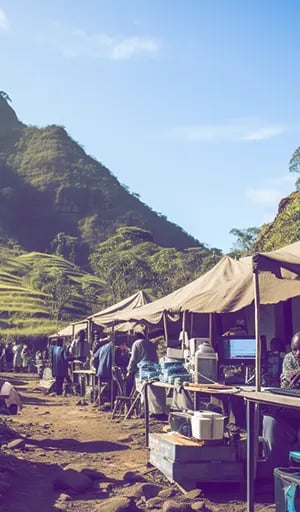Share this
research in low-resource regions is feasible with microsampling
by Neoteryx Microsampling on Sep 13, 2021 10:22:29 AM
 Scientists often find it challenging to collect specimen samples from study subjects in less developed countries for their research studies of malnutrition, infectious diseases, and other public health problems. One challenge is a lack of resources to keep the specimen samples stable during transport to a lab. For example, traditional wet blood samples collected in tubes must be kept frozen or chilled to maintain stability for accurate lab analysis.
Scientists often find it challenging to collect specimen samples from study subjects in less developed countries for their research studies of malnutrition, infectious diseases, and other public health problems. One challenge is a lack of resources to keep the specimen samples stable during transport to a lab. For example, traditional wet blood samples collected in tubes must be kept frozen or chilled to maintain stability for accurate lab analysis.
Lack of access to electricity and refrigeration for storage and cold-chain shipping of liquid samples makes it challenging to keep them stable and viable for bioanalysis.
Field researchers collecting samples in low-resource regions also contend with limited budgets; another problem that limits their research studies in many parts of the world. Limited funding often prevents them from acquiring and deploying the necessary supplies, equipment, and large medical teams they require to conduct studies in remote, under-developed settings.
Fortunately, dried blood spot (DBS) sampling cards and volumetric absorptive microsampling devices are two dried matrix sampling solutions that help researchers overcome these challenges of field research. There are, of course, pros and cons to consider when using these dried matrix sampling solutions, so let's take a closer look at the specific advantages and disadvantages.
Dried Matrix Sampling for Low-Resource Regions
Generally speaking, dried matrix sampling entails using a finger-stick method to collect small blood drops onto a filter card or onto a microsampling device specially made for dried blood spot analysis. The finger-stick sampling method has several advantages when used in low-resource field settings.
Pros:
- Dried blood samples don't require refrigeration, which simplifies storage and transport logistics when cold chain isn't available.
- Finger-stick sampling is an easy method that doesn’t require trained staff, such as phlebotomists, to perform.
- The dried matrix approach enhances the stability of the samples by preserving the analytes, even in tropical environments.
- Some volumetric microsampling devices reliably collect a fixed-volume specimen sample that consistently provide good data the bioanalytical lab
- Dried specimen samples furnish robust data that correlates well with traditional venipuncture liquid samples
Cons:
- DBS cards have a high failure rate, especially when samples are collected outside a clinical setting.
- Standard DBS has the potential for sampling bias. The uneven filling of samples in the spotting areas on the card leads to blood hematocrit issues that negatively impact quantitative measurements.
Differences in Sample Handling & Shipping
With the finger-stick sample collection method, capillary blood samples are ready to be transported as soon as they are dry. They don’t require dry ice or cooling equipment. However, the drying method differs when using a DBS filter card compared to using a microsampling device like the Mitra® device.
The DBS card, made of filter paper, must be left out to air-dry completely after blood sampling before it can be packaged for shipping. Not drying DBS cards thoroughly can cause them to contaminate other sampled cards contained in the same package. On the other hand, a Mitra microsampling device doesn't require the extra step of drying before shipment.
The Mitra devices come in a protective plastic cartridge and a sealable foil bag with a packet of drying desiccant inside. After collecting blood samples, Mitra users can close the devices in their cartridge and slip the cartridge case into the foil bag for immediate shipment. Thanks to the included desiccant, the samples dry within their protective bags during transit and are protected from contamination.
A Review of the Pros and Cons
Volumetric microsampling technologies, such as the Mitra device with the original, patented VAMS tips, eliminate the hematocrit bias of DBS cards, because they collect a fixed-volume blood sample. The samples collected using the VAMS technology have a lower sample rejection rate, which means that more high-quality samples contribute to the study data, without the need to return to the study population to repeat-sample them.
What may appear to be a disadvantage at the beginning of a study project is the price. Volumetric microsampling technologies can represent a higher cost than DBS cards. Research labs working in low-resource areas may not think they have the budget to cover the volumetric microsampling option, but once they account for the number of repeat-samples required with DBS cards, a cost-benefit analysis often shows that volumetric microsampling is more feasible. It is much more challenging to have to ask for more money partway through a project because it is necessary to repeat the sampling component in order to gather a sufficient number of useable samples.
For some researchers accustomed to processing and analyzing wet blood samples, finger-stick sampling deviates too much from their standard protocols. This has prevented the adoption of remote microsampling techniques on a broad scale among various labs. However, with the increasing need for remote technologies that can be reliably applied across a range of environments, more labs are starting to use microsampling, including the volumetric absorptive approach.
Share this
- Microsampling (206)
- Research, Remote Research (119)
- Venipuncture Alternative (105)
- Clinical Trials, Clinical Research (83)
- Mitra® Device (73)
- Therapeutic Drug Monitoring, TDM (51)
- Dried Blood Spot, DBS (39)
- Biomonitoring, Health, Wellness (30)
- Infectious Disease, Vaccines, COVID-19 (24)
- Blood Microsampling, Serology (23)
- Omics, Multi-Omics (21)
- Decentralized Clinical Trial (DCT) (20)
- Specimen Collection (18)
- Toxicology, Doping, Drug/Alcohol Monitoring, PEth (17)
- Skin Microsampling, Microbiopsy (14)
- hemaPEN® Device (13)
- Preclinical Research, Animal Studies (12)
- Pharmaceuticals, Drug Development (9)
- Harpera Device (7)
- Industry News, Microsampling News (5)
- Antibodies, MAbs (3)
- Company Press Release, Product Press Release (3)
- Environmental Toxins, Exposures (1)
- July 2025 (1)
- May 2025 (1)
- April 2025 (2)
- December 2024 (2)
- November 2024 (1)
- October 2024 (3)
- September 2024 (1)
- June 2024 (1)
- May 2024 (1)
- April 2024 (4)
- March 2024 (1)
- February 2024 (2)
- January 2024 (4)
- December 2023 (3)
- November 2023 (3)
- October 2023 (3)
- September 2023 (3)
- July 2023 (3)
- June 2023 (2)
- April 2023 (2)
- March 2023 (2)
- February 2023 (2)
- January 2023 (3)
- December 2022 (2)
- November 2022 (3)
- October 2022 (4)
- September 2022 (3)
- August 2022 (5)
- July 2022 (2)
- June 2022 (2)
- May 2022 (4)
- April 2022 (3)
- March 2022 (3)
- February 2022 (4)
- January 2022 (5)
- December 2021 (3)
- November 2021 (5)
- October 2021 (3)
- September 2021 (3)
- August 2021 (4)
- July 2021 (4)
- June 2021 (4)
- May 2021 (4)
- April 2021 (3)
- March 2021 (5)
- February 2021 (4)
- January 2021 (4)
- December 2020 (3)
- November 2020 (5)
- October 2020 (4)
- September 2020 (3)
- August 2020 (3)
- July 2020 (6)
- June 2020 (4)
- May 2020 (4)
- April 2020 (3)
- March 2020 (6)
- February 2020 (3)
- January 2020 (4)
- December 2019 (5)
- November 2019 (4)
- October 2019 (2)
- September 2019 (4)
- August 2019 (4)
- July 2019 (3)
- June 2019 (7)
- May 2019 (6)
- April 2019 (5)
- March 2019 (6)
- February 2019 (5)
- January 2019 (8)
- December 2018 (3)
- November 2018 (4)
- October 2018 (7)
- September 2018 (6)
- August 2018 (5)
- July 2018 (8)
- June 2018 (6)
- May 2018 (5)
- April 2018 (6)
- March 2018 (4)
- February 2018 (6)
- January 2018 (4)
- December 2017 (2)
- November 2017 (3)
- October 2017 (2)
- September 2017 (4)
- August 2017 (2)
- July 2017 (4)
- June 2017 (5)
- May 2017 (6)
- April 2017 (6)
- March 2017 (5)
- February 2017 (4)
- January 2017 (1)
- July 2016 (3)
- May 2016 (1)
- April 2016 (2)



No Comments Yet
Let us know what you think